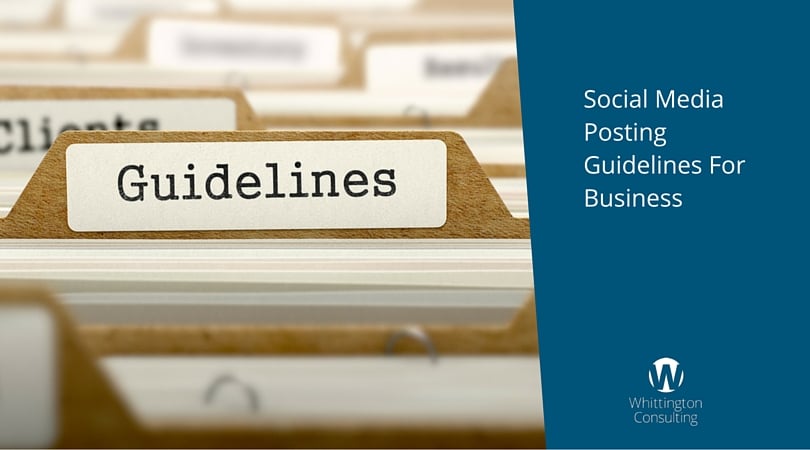Wouldn't it sound weird if you said the same thing to every person you encountered throughout the day?
Well, think of your social media posts in the same way. Each platform is different, and your posts should be too.
Even if you're linking to the same content on your own website, each post on your various social media accounts should be tailored to succeed on that specific site in terms of tone and appearance. Here are some social media posting guidelines and best practices for LinkedIn, Facebook and Twitter.
General Social Media Best Practices
Before we get into social media best practices for social media channels, let's cover some of the basics.
Use a style guide for social media posts.
In order to maintain brand alignment and consistency, you'll want to use a style guide for reference as you create social media content. Brand alignment will improve brand recall among your audience of ideal buyers so they remember your solution when they have a problem they're ready to get help for.
Focus ON YOUR buyer personas.
You'll need a social media strategy to ensure you meet your ideal customers where they are in their buyer journey. Having clear buyer personas will help you strategically reach the people you need to on your social media accounts.
Involve team members and encourage employees to participate.
Organic social media will only get you so far. Content with more interest and engagement gets seen by a wider audience, thanks to current social media algorithms. To get a wider reach and increase engagement, you'll want to include your team. When employees are encouraged to interact on social channels you not only get better results with your social media marketing, you get a more connected and excited company culture as well.
Develop a code of conduct for team members.
While team engagement is important, you'll want to remember that any engagement, positive or negative, could impact the perception of your company reputation. Employees should be reminded that any social content they publish or respond to is public information. When posting on behalf of the company or not on social, encourage employees to use common sense and be mindful of how they interact with others.
Now that we've covered the important points of social media best practices, let's go over channel-specific guidelines.
While social sites like Facebook and Twitter can be used to share any relevant content (your content or information from other websites), LinkedIn is a more professional platform and your posts should reflect this.
Companies and people often neglect posting to the LinkedIn news feed, even though it can send up to four times as many people to your homepage as Facebook and Twitter. This influx includes potential clients or even business partners, so try to highlight professional growth or achievements.
An appropriate post might be an article you wrote that demonstrates your prowess in your field, or a link to a press release or news clip that sheds positive light on your company. Photos are also great on LinkedIn, but always make sure to adjust it to the optimum size.
Using LinkedIn to attract new prospects
Pro tip: Your LinkedIn posts don't just need to go on the company page. Encourage employees to share messages on their personal profiles as well, and make sure your personal profile on LinkedIn is as good as it can be, too.
Now, there are certainly other social platforms that companies are using to generate awareness, find partners and drive website traffic, but managing too many social media platforms can be overwhelming because of the time involved and because you really need to tailor each of your messages to each social media platform for best results.
Third-party applications like HootSuite can definitely make it easier and quicker to manage your social media accounts, but they're not always the most effective method. By taking the time to ensure every post is optimized for its immediate audience instead of cross-posting the same one across all social media sites, you can leverage your content on each social media platform and ultimately drive traffic back to your company website.
Finally, posting and managing social media could be a full time job for many larger B2B companies, so don't spread yourself too thin. Consider scheduling social media posts so you have even distribution throughout the day/week/month.
Facebook is for social sharing, so go ahead: add photos, add links, add events, add it all.
The Facebook feed is visually oriented, and aesthetics are important: use high quality photos (1,200x628 pixels is ideal) and replace visible URLs with well-written text to create a visually appealing post that catches the eye. Photo-based posts (rather than text-based ones) actually get 39% more engagement on average. And remember to make it friendly.
Pro tip: One gentleman from a manufacturing company told me that their Facebook feed "is like the company newsletter." I thought that was great advice. Facebook is a good place to attract new employees.
Tweets, on the other hand, must be economical. They're meant to be short and pithy and to capture the audience's attention with intrigue and wit rather than explanation.
Don't worry about aesthetics here; just make sure you maximize your word allotment. Use tools like goo.gl or Bitly to shorten your links (many social sharing tools will shorten links for you automatically, too), saving space for valuable hashtags that increase your tweet's exposure.
You can also add photos (ideally 1,024x512 pixels) and tag them, neither of which takes up any of your 280 characters.
Pro tip: We've found Twitter to be a great tool for finding influencers in an industry or on a topic, and also is good to send cues to search engines to index new pages you tweet about.









